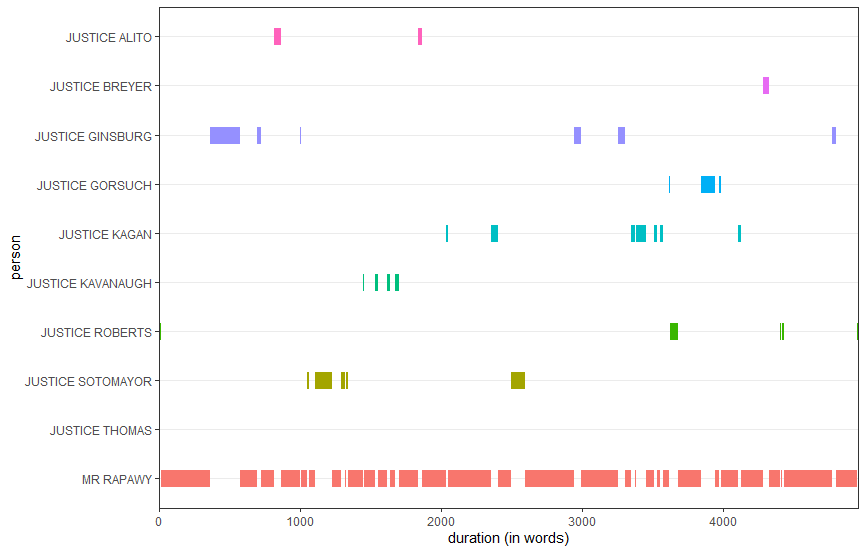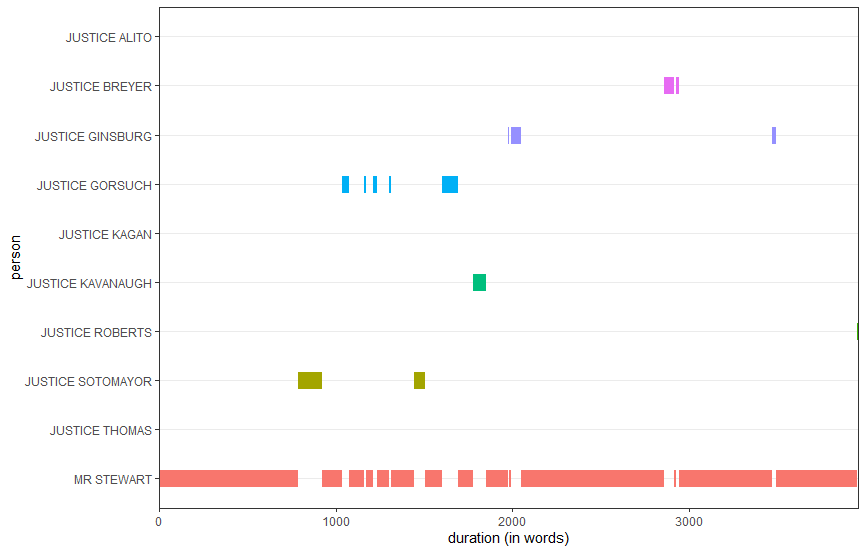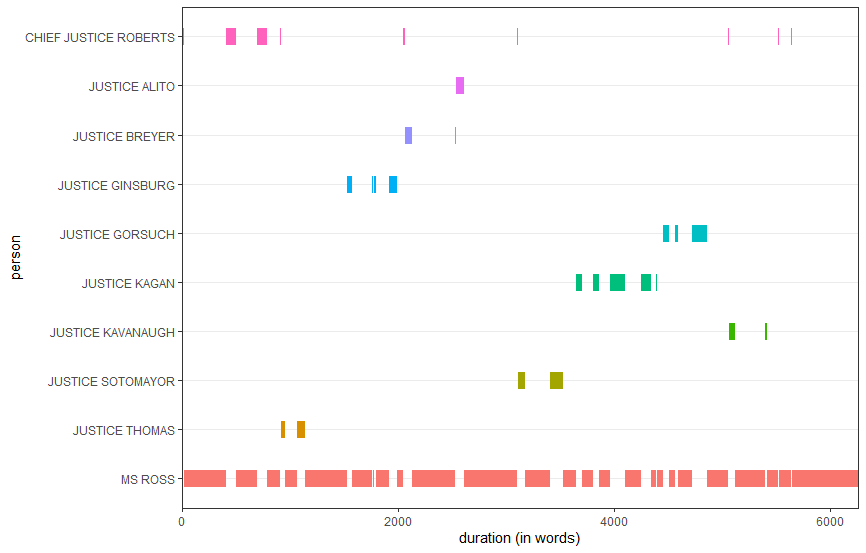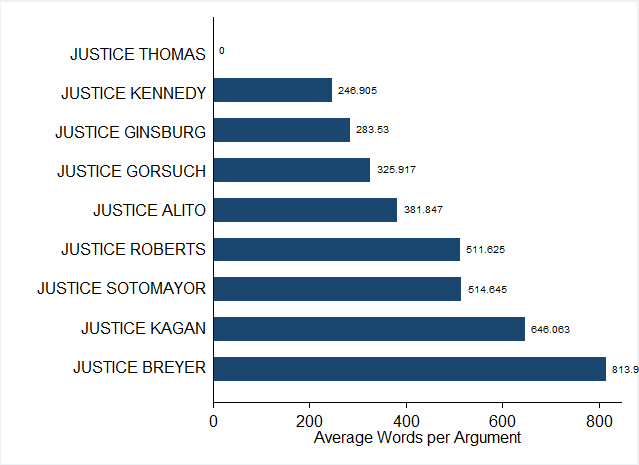Empirical SCOTUS: Changes in Supreme Court oral argument format: The good, the bad and the ugly

on May 19, 2020 at 1:11 pm
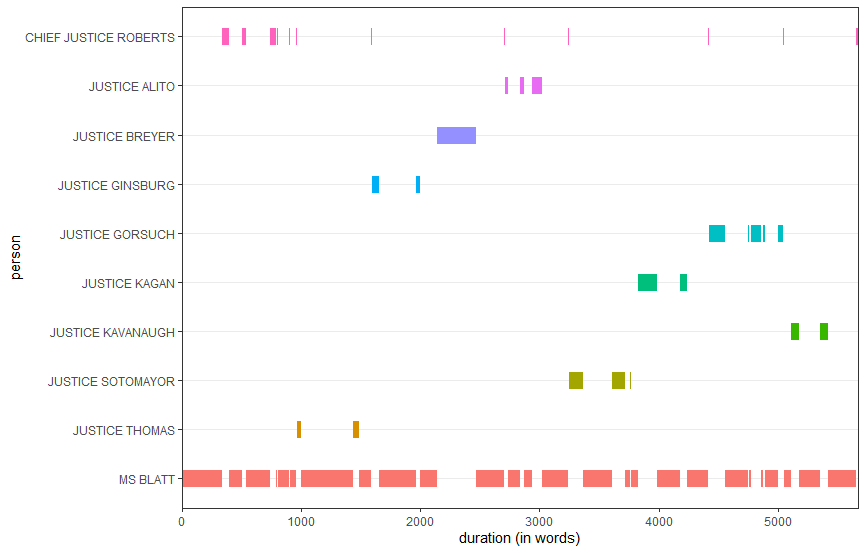
Editor’s note: This is the first post in a series analyzing the Supreme Court’s telephonic oral arguments with live audio instituted due to the COVID-19 pandemic.
The first week of the Supreme Court’s telephonic oral arguments provided meaningful data points to compare old-style oral arguments with the new framework. These new arguments were not without mishaps, as justices and attorneys attempted to navigate this unfamiliar terrain. Using Supreme Court transcript data and audio recordings, we can examine the changes accompanying this new format with the same methods used to analyze past oral arguments. Most signs point to a favorable evolution, as there was plenty of engagement, including from Justice Clarence Thomas, who has seldom spoken in the past. Still, not everyone in the Supreme Court world was pleased with the new format, as it is clear some of the kinks in the system need to worked out.
The data in this post was taken from the four telephonic arguments from the week of May 4: U.S. Patent and Trademark Office v. Booking.com B.V., U.S. Agency for Int’l Development v. Alliance for Open Society Int’l, Barr v. American Association of Political Consultants Inc. and Little Sisters of the Poor Saints Peter and Paul Home v. Pennsylvania. This was then compared with data from the four most recent arguments prior to the format change: June Medical Services LLC v. Russo, Liu v. Securities and Exchange Commission, Seila Law LLC v. Consumer Financial Protection Bureau and Department of Homeland Security v. Thuraissigiam. The small sample set presents an opportunity to examine the costs and benefits of this new format, although we don’t yet know whether any aspects of the format will be retained in future Supreme Court oral arguments.
One thing that is clear from the new format is that Chief Justice John Roberts is forced to have a greater role in the organization of the proceedings as he dictates when a justice’s turn to interact with an attorney begins and ends. In a recent paper, Rebecca Gill and I recommended such a change in oral arguments to prevent justices from vying for chances to speak, often cutting off each other as well as the advocates in the process. So far, this tactic appears successful.
An example from the charts below shows the justices’ and attorneys’ turns speaking in the pre-telephonic argument in Liu. The first graph looks at the petitioner’s argument and the second graph looks at the respondent’s argument. Each bar represents an actor’s turn talking. The bars reflect the number of words spoken during each talking turn.
This graph indicates that there was little order to the proceedings aside from the uninterrupted opening statement by the advocate for the petitioner, Gregory Rapawy. All justices except Thomas engaged in the discussion, and all but Justice Stephen Breyer spoke at multiple points during the argument and interjected when others were speaking. This disorder allowed justices to respond to other justices’ points, but also allowed one justice to stop the attorney in the midst of responding to another justice’s question.
The respondent’s attorney, Malcolm Stewart, had much more uninterrupted time speaking before the justices. The justices were not as aggressive in interrupting during Stewart’s argument and they appeared more orderly in taking turns. Justice Samuel Alito did not speak at all during Stewart’s argument and Roberts only interceded at the end of the argument to declare that the respondent’s time was complete. This set of arguments demonstrates that the justices were more free to define when they spoke, and did not feel compelled to speak to both sides in equal or nearly equal amounts. This is quite different in the telephonic arguments. The example below shows the petitioner’s and then the respondent’s arguments in the Booking.com case.
Here we see a more ordered approach, with each justice speaking in turn aside from Roberts, who jumps in to help transition between justices’ turns. Although the amounts of speech are not equal (compare the lines for Alito and Justice Elena Kagan, for example), each justice was given an uninterrupted turn with the petitioner’s attorney, Erica Ross. The same was true for the justices’ turns with the respondent’s attorney, Lisa Blatt, below.
The respondent’s chart here is quite similar to the one for the petitioner’s argument in terms of the order of the questioning, with Roberts also interceding between each justice’s turn. The justices did not all speak in equal amounts to both attorneys, however. Breyer was quite voluble during Blatt’s turn and much less so during Ross’ turn. Thomas and to some extent Alito were both fairly reticent during both arguments, while Kagan and Justice Neil Gorsuch engaged both attorneys more.
The main metrics I used to track oral argument participation across both sets of arguments were words per argument and words per turn. Both the justices and the attorneys averaged increased numbers for both measures in the new arguments. In all the charts below, the blue bars are for arguments in the newer cases and the orange bars are for arguments in the older cases.
Just as a note, Thomas was silent in all four arguments prior to the argument format change, and Gorsuch spoke in only two of the four older arguments. All other justices participated in each of the eight arguments except Kagan, who was recused in the Alliance for Open Society case. For the statistical analysis, Gorsuch was given zero words for the two arguments in which he did not speak, Thomas was given zero words for all four arguments in which he did not speak, and Kagan’s speech was averaged across the three telephonic arguments in which she participated, because she spoke at each.
The first graph compares words-spoken averages between the old- and new-format arguments.
All four arguments in the new format were scheduled for an hour apiece, while three of the old-format arguments were scheduled for one hour, with one (Seila Law) scheduled for 70 minutes. It’s worth noting, however, that many of the four new arguments analyzed ran longer than their allotted 60 minutes, in particular the argument in Little Sisters. The 1,000-word bump in the average words attorneys spoke in oral arguments in the new format is most noticeable. The parallel increase in words per turn suggests that the new structure allows attorneys more room to participate as they are only asked questions by one justice at a time. The justices appear more engaged as well, speaking more both in total and per turn in the new arguments. This likely has to do with the new format’s eliminating competition for talking time and instead offering the justices uninterrupted interactions with the attorneys. On the other hand, they are prevented from asking follow-up questions and, especially for the senior justices who have their turn earlier in the arguments, there is less room to piggyback on other justices’ points.
Breaking these numbers down by individual justice, we see that all aside from Breyer and Justices Sonia Sotomayor and Ruth Bader Ginsburg (ever so slightly) spoke more in the new format.
Kagan, Roberts and Gorsuch showed the biggest changes from the old argument format to the new, although Gorsuch’s old numbers were brought down by the two arguments prior to the shift in format in which he did not speak. Thomas’ numbers obviously increased, as he only spoke in two arguments in the 14 years prior to the format change. Alito’s and Justice Brett Kavanaugh’s increases in the new format were much more modest.
Roberts’ numbers in the new arguments might be slightly inflated by the additional role he took on as timekeeper, but when we look at his averages from past terms, he actually tended to speak over 500 words per argument, much closer to his average for the post-telephonic arguments. Thus, his statistics from the four arguments in OT 2019 before the change in format might not be representative of his general oral argument participation. The graph below, taken from a prior post, shows the justices’ average words per argument from OT 2016.
The chart below breaks down the amount of words each justice spoke in each of the four new-format arguments examined in this post.
Sotomayor and Roberts spoke most in one argument each. Although Thomas participated in each of the four new-format arguments, he spoke least of the justices in each of them, maintaining his low profile to some degree. Ginsburg, joining oral arguments from the hospital after being treated for a gallbladder condition, spoke third-most in the Little Sisters of the Poor argument and spoke the second fewest words in the American Association of Political Consultants argument, after Thomas.
The change in argument format offers an interesting lens into potential improvements for oral arguments moving forward. The justices seem to be participating more in the new format and to have a greater chance to interact with the attorneys. Attorneys, too, appear more able to respond to questions, as they are peppered with fewer of them and by only one justice at a time. Although the benefits of the new format are clear, the costs of preventing justices from asking questions outside of their allotted time might be great as well. We will never know the extent of such costs, but the new format at least presents a good case study of the differences that are a product of a more ordered process.
A previous version of this post was published at Empirical SCOTUS.



